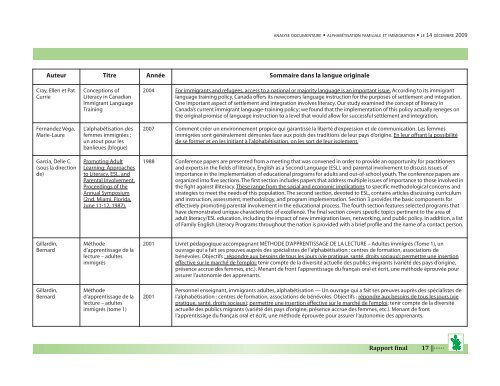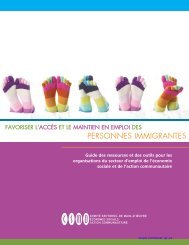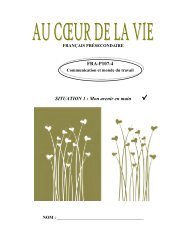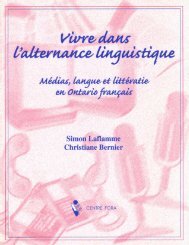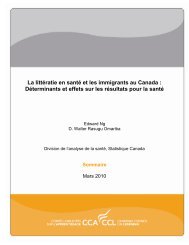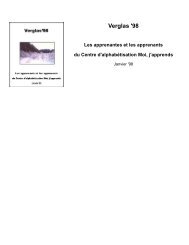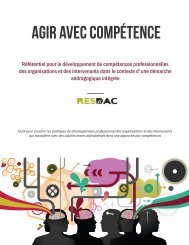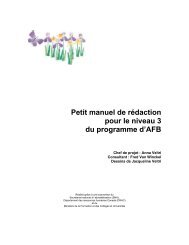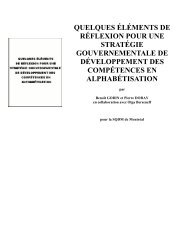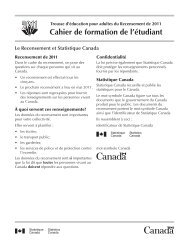L'alphabétisation familiale et l'immigration en milieu - Base de ...
L'alphabétisation familiale et l'immigration en milieu - Base de ...
L'alphabétisation familiale et l'immigration en milieu - Base de ...
- No tags were found...
Create successful ePaper yourself
Turn your PDF publications into a flip-book with our unique Google optimized e-Paper software.
ANALYSE DOCUMENTAIRE • ALPHABÉTISATION FAMILIALE ET IMMIGRATION • LE 14 DÉCEMBRE 2009Auteur Titre Année Sommaire dans la langue originaleCray, Ell<strong>en</strong> <strong>et</strong> PatCurrieFernan<strong>de</strong>z Véga,Marie-LaureGarcia, Delie C.(sous la direction<strong>de</strong>)Conceptions ofLiteracy in CanadianImmigrant LanguageTrainingL’alphabétisation <strong>de</strong>sfemmes immigrées :un atout pour lesbanlieues (blogue)Promoting AdultLearning: Approachesto Literacy, ESL, andPar<strong>en</strong>tal Involvem<strong>en</strong>t.Proceedings of theAnnual Symposium(2nd, Miami, Florida,June 11-12, 1987).2004 For immigrants and refugees, access to a national or majority language is an important issue. According to its immigrantlanguage training policy, Canada offers its newcomers language instruction for the purposes of s<strong>et</strong>tlem<strong>en</strong>t and integration.One important aspect of s<strong>et</strong>tlem<strong>en</strong>t and integration involves literacy. Our study examined the concept of literacy inCanada’s curr<strong>en</strong>t immigrant language-training policy; we found that the implem<strong>en</strong>tation of this policy actually r<strong>en</strong>eges onthe original promise of language instruction to a level that would allow for successful s<strong>et</strong>tlem<strong>en</strong>t and integration.2007 Comm<strong>en</strong>t créer un <strong>en</strong>vironnem<strong>en</strong>t propice qui garantisse la liberté d’expression <strong>et</strong> <strong>de</strong> communication. Les femmesimmigrées sont généralem<strong>en</strong>t démunies face aux poids <strong>de</strong>s traditions <strong>de</strong> leur pays d’origine. En leur offrant la possibilité<strong>de</strong> se former <strong>et</strong> <strong>en</strong> les initiant à l’alphabétisation, on les sort <strong>de</strong> leur isolem<strong>en</strong>t.1988 Confer<strong>en</strong>ce papers are pres<strong>en</strong>ted from a me<strong>et</strong>ing that was conv<strong>en</strong>ed in or<strong>de</strong>r to provi<strong>de</strong> an opportunity for practitionersand experts in the fields of literacy, English as a Second Language (ESL), and par<strong>en</strong>tal involvem<strong>en</strong>t to discuss issues ofimportance in the implem<strong>en</strong>tation of educational programs for adults and out-of-school youth. The confer<strong>en</strong>ce papers areorganized into five sections. The first section inclu<strong>de</strong>s papers that address multiple issues of importance to those involved inthe fight against illiteracy. These range from the social and economic implications to specific m<strong>et</strong>hodological concerns andstrategies to me<strong>et</strong> the needs of this population. The second section, <strong>de</strong>voted to ESL, contains articles discussing curriculumand instruction, assessm<strong>en</strong>t, m<strong>et</strong>hodology, and program implem<strong>en</strong>tation. Section 3 provi<strong>de</strong>s the basic compon<strong>en</strong>ts foreffectively promoting par<strong>en</strong>tal involvem<strong>en</strong>t in the educational process. The fourth section features selected programs thathave <strong>de</strong>monstrated unique characteristics of excell<strong>en</strong>ce. The final section covers specific topics pertin<strong>en</strong>t to the area ofadult literacy/ESL education, including the impact of new immigration laws, n<strong>et</strong>working, and public policy. In addition, a listof Family English Literacy Programs throughout the nation is provi<strong>de</strong>d with a brief profile and the name of a contact person.Gillardin,BernardMétho<strong>de</strong>d’appr<strong>en</strong>tissage <strong>de</strong> lalecture – adultesimmigrés2001 Livr<strong>et</strong> pédagogique accompagnant MÉTHODE D’APPRENTISSAGE DE LA LECTURE – Adultes immigrés (Tome 1), unouvrage qui a fait ses preuves auprès <strong>de</strong>s spécialistes <strong>de</strong> l’alphabétisation : c<strong>en</strong>tres <strong>de</strong> formation, associations <strong>de</strong>bénévoles. Objectifs : répondre aux besoins <strong>de</strong> tous les jours (vie pratique, santé, droits sociaux); perm<strong>et</strong>tre une insertioneffective sur le marché <strong>de</strong> l’emploi; t<strong>en</strong>ir compte <strong>de</strong> la diversité actuelle <strong>de</strong>s publics migrants (variété <strong>de</strong>s pays d’origine,prés<strong>en</strong>ce accrue <strong>de</strong>s femmes, <strong>et</strong>c.). M<strong>en</strong>ant <strong>de</strong> front l’appr<strong>en</strong>tissage du français oral <strong>et</strong> écrit, une métho<strong>de</strong> éprouvée pourassurer l’autonomie <strong>de</strong>s appr<strong>en</strong>ants.Gillardin,BernardMétho<strong>de</strong>d’appr<strong>en</strong>tissage <strong>de</strong> lalecture – adultesimmigrés (tome 1)2001Personnel <strong>en</strong>seignant, immigrants adultes, alphabétisation — Un ouvrage qui a fait ses preuves auprès <strong>de</strong>s spécialistes <strong>de</strong>l’alphabétisation : c<strong>en</strong>tres <strong>de</strong> formation, associations <strong>de</strong> bénévoles. Objectifs : répondre aux besoins <strong>de</strong> tous les jours (viepratique, santé, droits sociaux); perm<strong>et</strong>tre une insertion effective sur le marché <strong>de</strong> l’emploi; t<strong>en</strong>ir compte <strong>de</strong> la diversitéactuelle <strong>de</strong>s publics migrants (variété <strong>de</strong>s pays d’origine, prés<strong>en</strong>ce accrue <strong>de</strong>s femmes, <strong>et</strong>c.). M<strong>en</strong>ant <strong>de</strong> frontl’appr<strong>en</strong>tissage du français oral <strong>et</strong> écrit, une métho<strong>de</strong> éprouvée pour assurer l’autonomie <strong>de</strong>s appr<strong>en</strong>ants.Rapport inal 17 ||······


